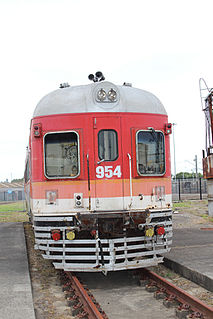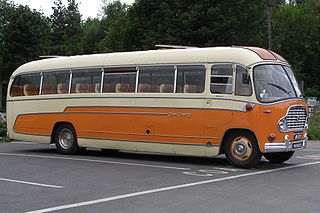
A railbus is a lightweight passenger railcar that shares many aspects of its construction with a bus, typically having a bus body and four wheels on a fixed base, instead of on bogies. Originally designed and developed during the 1930s, railbuses have evolved into larger dimensions, with characteristics similar in appearance to a light railcar, with the terms railcar and railbus often used interchangeably. Railbuses designed for use specifically on little-used railway lines were commonly employed in countries such as Germany, Italy, France, the United Kingdom and Sweden.

British Rail produced a variety of railbuses, both as a means of acquiring new rolling stock cheaply, and to provide economical services on lightly-used lines.

Seddon Atkinson Vehicles Limited, a manufacturer of large goods vehicles based in Oldham, Greater Manchester, England, was formed after the acquisition in 1970 of Atkinson Vehicles Limited of Preston by Seddon Diesel Vehicles Limited of Oldham. In 1974, the firm was acquired by International Harvester, which sold it in March 1984 to the Spanish group Enasa which made it a subsidiary of Pegaso. In 1990, it became part of Iveco which used the brand for various types of specialised vehicles in the United Kingdom. The range of models produced included EuroMover, Pacer and Strato, which are aimed at refuse collection, recycling and construction operators.

The Leyland Atlantean is a predominantly double-decker bus chassis manufactured by Leyland Motors between 1958 and 1986. Only 17 Atlantean chassis were bodied as single deck from new.

The 620/720 class railcars were a class of diesel multiple unit built by the New South Wales Government Railways and operated from 1961 until 2007.

The New Zealand DM/D class electric multiple unit were a type of electric multiple units used on the suburban rail network of Wellington, New Zealand. Formed of DM power cars and D trailer cars, the first units were ordered from English Electric in 1936 and introduced on 2 July 1938 operating the electrified Johnsonville Line service. Additional units were ordered in 1942 for the line, and in 1946 as the other Wellington suburban lines were to be electrified.

The Leyland Leopard was a mid-engined single-decker bus and single-decker coach chassis manufactured by Leyland between 1959 and 1982.

The 44 class are a class of diesel-electric locomotives built by AE Goodwin, Auburn for the New South Wales Department of Railways between 1957 and 1967.
The railways of New South Wales, Australia, use a large variety of passenger and freight rolling stock. The first railway in Sydney was opened in 1855 between Sydney and Granville, now a suburb of Sydney but then a major agricultural centre. The railway formed the basis of the New South Wales Government Railways. Passenger and freight services were operated from the beginning. By 1880, there was a half hourly service to Homebush.

The Daimler Fleetline is a rear-engined double-decker bus chassis which was built between 1960 and 1983.

The AD60 class were Beyer-Garratt patent articulated four-cylinder, simple, non-condensing, coal-fired superheated, 4-8-4+4-8-4 heavy goods steam locomotives built by Beyer, Peacock and Company for the New South Wales Government Railways in Australia.

The 900/800 class railcars were Diesel Multiple Units built by the New South Wales Government Railways between November 1951 and November 1960.

Locomotive 3642 is a two-cylinder, simple, non-condensing, coal-fired superheated, 4-6-0 36 class express passenger steam locomotive built for the New South Wales Government Railways in 1926 by Clyde Engineering. It is one of three 36 class locomotives that were preserved.

The Bedford SB was a front-engined bus chassis manufactured by Bedford in England. It was launched at the 1950 Commercial Motor Show as the replacement for the Bedford OB.
The Seddon Pennine RU was a rear-engined single-decker bus built by Seddon Diesel Vehicles/Seddon Atkinson between 1969 and 1974.

The Leyland Tiger was a heavyweight half-cab single-decker bus and coach chassis built by Leyland Motors between 1927 and 1968, except the period of World War II.

The Leyland Royal Tiger Worldmaster, sometimes simply known as the Leyland Worldmaster, was a mid-underfloor-engined single-decker bus or single-decker coach chassis manufactured by Leyland between 1954 and 1979.

The South Australian Railways Model Brill railcar were two types of railcars operated by the South Australian Railways between 1925 and 1971. Introduced to run on country rail services, the "Barwell Bulls" serviced most of the state's railway lines until they were eventually replaced by both the Bluebird and Redhen railcars, with the last units withdrawn in 1971.

The 400/500 class rail motors are diesel trains built by New South Wales Government Railways primarily for use on regional lines throughout NSW. The trains have since been phased out following a rationalisation of country branch line rail services in November 1983. The 400 Class power cars were built in 1938 at the Eveleigh Carriage Workshops, while the 500 Class trailer cars were built by Ritchie Brothers at Auburn.
Rail Paybus FP1 is a heritage-listed former railbus and now museum exhibit at NSW Rail Transport Museum Barbour Road, in the outer south-western Sydney town of Thirlmere in the Wollondilly Shire local government area of New South Wales, Australia. It was designed by the New South Wales Government Railways Road Motor Section and built in 1937 by Waddingtons Ltd (body), Ford Motor Co.. It is also known as Rail Bus and Rail Pay Bus FP1. The property is owned by Rail Corporation New South Wales, an agency of the Government of New South Wales. It was added to the New South Wales State Heritage Register on 26 September 2003.


















